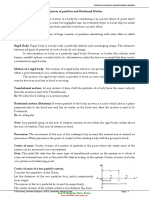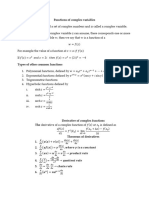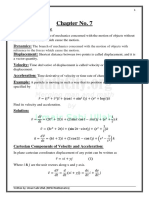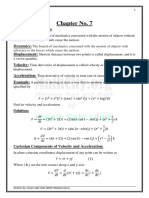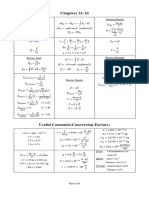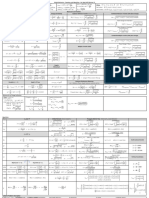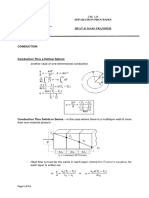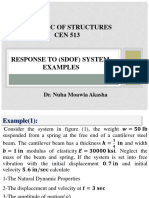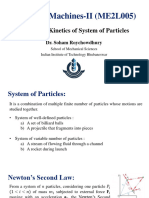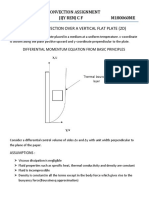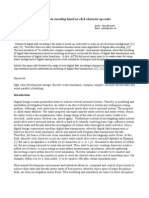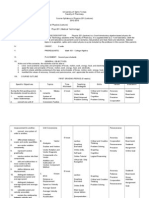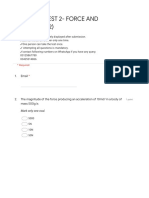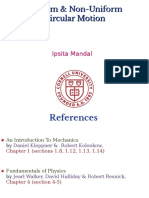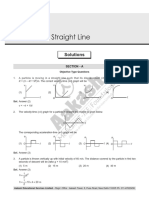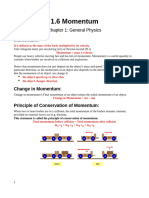Selected Solutions of Problem Set 1
Selected Solutions of Problem Set 1
Uploaded by
abel.aryanghoshCopyright:
Available Formats
Selected Solutions of Problem Set 1
Selected Solutions of Problem Set 1
Uploaded by
abel.aryanghoshOriginal Title
Copyright
Available Formats
Share this document
Did you find this document useful?
Is this content inappropriate?
Copyright:
Available Formats
Selected Solutions of Problem Set 1
Selected Solutions of Problem Set 1
Uploaded by
abel.aryanghoshCopyright:
Available Formats
Selected Solutions of Problem set 1
1. Two particles of masses 𝑚 and 𝑚 move so that their relative velocity is 𝒗 and the
velocity of their center of mass is 𝒗. If the total mass of the system is 𝑀 = 𝑚 + 𝑚 and
𝜇= (called the reduced mass), prove that the kinetic energy of the system is
𝒎𝟏 𝒎𝟐
𝑀𝑣̅ + 𝜇𝑣 .
Solution
Suppose the coordinates of the masses 𝑚 , 𝑚 are respectively 𝒓 , 𝒓 . The relative coordinate
(of mass 𝑚 with respect to 𝑚 ) is then 𝒓 = 𝒓 − 𝒓 . If the coordinate of the center of mass
is 𝑹, then
𝑚 𝒓 +𝑚 𝒓
𝑹= (1)
𝑀
The velocity of the center of mass is then
𝑑𝑹 𝑚 𝒓̇ + 𝑚 𝒓̇
𝑣̅ = = (2)
𝑑𝑡 𝑀
where 𝑀 = 𝑚 + 𝑚 . The coordinates of the particles relative to the center of mass is
𝑚 𝒓 +𝑚 𝒓 𝑚 (𝒓 − 𝒓 ) 𝑚
𝒓 =𝒓 −𝑹=𝒓 − = = 𝒓
𝑚 +𝑚 𝑚 +𝑚 𝑚 +𝑚
Noting that 𝜇 = , we get
𝒓
𝜇 𝒓
𝒓 = 𝒓.
𝑚
𝒓
Similarly,
𝜇
𝒓𝟐 = − 𝒓.
𝑚
Now the total kinetic energy (KE) of the system
= Kinetic energy of the motion of center of mass with the entire mass concentrated on it
+ Kinetic energy of motion of the particles about the center of mass
1 1 𝟐
= 𝑀𝑣̅ + 𝑚 𝒓̇ (3)
2 2
For the second term in Eq. (3),
𝜇 𝜇
𝑚 𝒓̇ =𝑚 𝒓̇ + 𝑚 𝒓̇
𝑚 𝑚
1 1 1
= + 𝜇 𝒓̇ = 𝜇 𝒓̇ = 𝜇𝒓̇
𝑚 𝑚 𝜇
Therefore from Eq. (3),
The total KE = 𝑀𝑣̅ + 𝜇𝒗 .
1. Prove the result
∇⃗ 𝑉 = ∇⃗ 𝑉 = −∇⃗ 𝑉 .
Partial solution
𝑉 =𝑉 𝒓 −𝒓 =𝑉 𝒓 =𝑉 𝑟 , (1)
where 𝑟 = 𝑥 −𝑥 + 𝑦 −𝑦 + 𝑧 −𝑧 = 𝑥 +𝑦 +𝑧 .
𝜕𝑉 𝜕𝑉 𝜕𝑉
∇⃗ 𝑉 = 𝚤̂ + 𝚥̂ +𝑘 . (2)
𝜕𝑥 𝜕𝑦 𝜕𝑧
𝜕𝑉 𝜕𝑉 𝜕𝑟
=
𝜕𝑥 𝜕𝑟 𝜕𝑥
𝜕𝑉 1 2 𝑥 −𝑥
= ×
𝜕𝑟 2 𝑟
𝜕𝑉 𝑥 −𝑥 𝜕𝑉 𝑥
= = (3)
𝜕𝑟 𝑟 𝜕𝑟 𝑟
Also,
𝜕𝑉 𝜕𝑉 𝜕𝑟 𝜕𝑉 𝑥
= =
𝜕𝑥 𝜕𝑟 𝜕𝑥 𝜕𝑟 𝑟
Substituting in Eq. (3) we have,
𝜕𝑉 𝜕𝑉
= .
𝜕𝑥 𝜕𝑥
Similarly compute , and finally ∇⃗ 𝑉 . The other part containing ∇⃗ 𝑉 is proved in a
similar way.
You might also like
- Easy Notes On Mechanics Moment of Inertia PDFDocument48 pagesEasy Notes On Mechanics Moment of Inertia PDFFaisal Shabbir0% (2)
- Homework - Deriving Almansi Strain in Terms of DisplacementDocument2 pagesHomework - Deriving Almansi Strain in Terms of DisplacementJohn Mark Go PayawalNo ratings yet
- Keplers LawsDocument7 pagesKeplers LawsShumailaNo ratings yet
- What Are The Lagrange's Equations of Motion in A Plane In, (A) Cartesian Coordinates (B) Polar CoordinatesDocument9 pagesWhat Are The Lagrange's Equations of Motion in A Plane In, (A) Cartesian Coordinates (B) Polar Coordinatesabel.aryanghoshNo ratings yet
- Classicalmechanics Study Material NEP 2Document4 pagesClassicalmechanics Study Material NEP 2Shree SNo ratings yet
- 1st Puc Physics Chapter7-System of Particles and Rotational Motion Notes by U N SwamyDocument30 pages1st Puc Physics Chapter7-System of Particles and Rotational Motion Notes by U N Swamyashwinikumari b100% (1)
- Equivalent Inductance of Magnetically Coupled Parallel Two InductorsDocument4 pagesEquivalent Inductance of Magnetically Coupled Parallel Two InductorsOzan AbutNo ratings yet
- Measurements Assignment Three FinalDocument8 pagesMeasurements Assignment Three FinalByonabye MosesNo ratings yet
- Worksheet 1Document4 pagesWorksheet 1lusizo.nqwenisolNo ratings yet
- Statistical Mechanics (part-II)Document30 pagesStatistical Mechanics (part-II)Shadow GamingNo ratings yet
- 15.3 Double Integrals in Polar CoordinatesDocument15 pages15.3 Double Integrals in Polar Coordinateschoimg050520No ratings yet
- TM CM L11 4 PDFDocument1 pageTM CM L11 4 PDFsayandatta1No ratings yet
- Ejercicios Resolver Los Siguientes Ejercicios. 1Document2 pagesEjercicios Resolver Los Siguientes Ejercicios. 1ManuelMaciasNo ratings yet
- Class Lecture Week 1Document11 pagesClass Lecture Week 1utshopaul0002No ratings yet
- Phy 413 Lecture Three NotesDocument3 pagesPhy 413 Lecture Three Notesprudence.chepngenoNo ratings yet
- Class7 - Energy MethodDocument46 pagesClass7 - Energy MethodAlvinNo ratings yet
- Geophysics FormulaeDocument4 pagesGeophysics FormulaeSwarnoboomNo ratings yet
- Applications of Bernoulli's Theorem - Student - NotesDocument18 pagesApplications of Bernoulli's Theorem - Student - Notesbrianthiru04No ratings yet
- Ch07 Kinematics Umair Sabi UllahDocument15 pagesCh07 Kinematics Umair Sabi UllahMisbah SulemanNo ratings yet
- Ch07 Kinematics Umair Sabi UllahDocument15 pagesCh07 Kinematics Umair Sabi Ullahpinpost00No ratings yet
- 2.3 Diesel CycleDocument15 pages2.3 Diesel CycleSan Jose, Kyla Mae M.No ratings yet
- JEST 2020 Physics Solutions Scienceteen 0cktrpDocument45 pagesJEST 2020 Physics Solutions Scienceteen 0cktrpVAISHNAVI V.GNo ratings yet
- 1.5 Vectors and Vector AlgebraDocument8 pages1.5 Vectors and Vector Algebrabakrsa3eed77No ratings yet
- P10 11bDocument4 pagesP10 11bPrayoga Agusto100% (1)
- PDFsam MergeDocument4 pagesPDFsam Mergeyasiv29532No ratings yet
- PHY108 Spring22 EquationSheet4Document3 pagesPHY108 Spring22 EquationSheet4yasiv29532No ratings yet
- Chain Rule For Several Independent VariablesDocument3 pagesChain Rule For Several Independent Variablesmalikabdulah425No ratings yet
- Approximate Velocity Profiles For The Laminar BDocument3 pagesApproximate Velocity Profiles For The Laminar BAsmaa MahmoudNo ratings yet
- Astro 310 Equation Sheet Spring 2023Document2 pagesAstro 310 Equation Sheet Spring 2023Jay StearnsNo ratings yet
- A 4 TH Order 7-Dimensional Polynomial WHDocument11 pagesA 4 TH Order 7-Dimensional Polynomial WHAkshaya Kumar RathNo ratings yet
- L2 - Satellite Orbital Motion - P3Document15 pagesL2 - Satellite Orbital Motion - P3Anil SubediNo ratings yet
- Orbital Mechanics Reference Sheets Equations and Algorithms 1689515592Document2 pagesOrbital Mechanics Reference Sheets Equations and Algorithms 1689515592anantha karurNo ratings yet
- Newton's Motion Lecture 3Document19 pagesNewton's Motion Lecture 3derrickkashimba240No ratings yet
- BB Conduction-and-ConvectionDocument13 pagesBB Conduction-and-ConvectionRamon LlonaNo ratings yet
- Time Dependent Schrödinger Wave EquationDocument8 pagesTime Dependent Schrödinger Wave EquationMuhammad Saif ullah100% (1)
- Gravitation and Central Force MotionDocument10 pagesGravitation and Central Force Motionsutapadey276No ratings yet
- Dynamic of Structures Lec 7 EXAMPLESDocument58 pagesDynamic of Structures Lec 7 EXAMPLESMouid JaberNo ratings yet
- Kinematics of Particles: Polar Coordinates (r-θ)Document33 pagesKinematics of Particles: Polar Coordinates (r-θ)son gokuNo ratings yet
- Lecture 5-Kinetics of System of ParticlesDocument13 pagesLecture 5-Kinetics of System of Particlesatharvapatil518No ratings yet
- 11th Phy Practice Sheet 5Document41 pages11th Phy Practice Sheet 5vanshu01122007No ratings yet
- Eulerian Vs Lagrangian Description and MoreDocument10 pagesEulerian Vs Lagrangian Description and MoreVeysel KabaNo ratings yet
- CH 9Document41 pagesCH 9kw46y74ynqNo ratings yet
- PHYS2002 Thermal Physics Q&ADocument3 pagesPHYS2002 Thermal Physics Q&ASaraNo ratings yet
- Formulas TermodinamicasDocument1 pageFormulas TermodinamicasEdgar AgusNo ratings yet
- Semi-Implicit Method For Pressure-Linked Equations (SIMPLE) - Solution in MATLAB®Document14 pagesSemi-Implicit Method For Pressure-Linked Equations (SIMPLE) - Solution in MATLAB®jackimNo ratings yet
- IA QP and SolutionDocument11 pagesIA QP and SolutionNitishNo ratings yet
- L2 - Satellite Orbital Motion - P2Document20 pagesL2 - Satellite Orbital Motion - P2Anil SubediNo ratings yet
- 3.2 Monochromatic Plane WavesDocument3 pages3.2 Monochromatic Plane Wavesmuhammadnaeem4957No ratings yet
- PHYS 101 - General Physics I Final Exam Solution (17.05.2022)Document5 pagesPHYS 101 - General Physics I Final Exam Solution (17.05.2022)Tuğba AydemirNo ratings yet
- Vibration Lecture 3Document44 pagesVibration Lecture 3منذر كمالNo ratings yet
- Free Convection PDFDocument9 pagesFree Convection PDFaditya a pNo ratings yet
- Formulario Ing de FluidosDocument1 pageFormulario Ing de FluidosSarah CortésNo ratings yet
- IPhO20212 T1-T3 SolutionDocument25 pagesIPhO20212 T1-T3 SolutionlucivandolopesNo ratings yet
- Planetary Physics (10 Points) : Theoretical Question 1 - SolutionDocument7 pagesPlanetary Physics (10 Points) : Theoretical Question 1 - SolutionErvan Maulana IlyasNo ratings yet
- Chapter 1.1 - The Wave EquationDocument26 pagesChapter 1.1 - The Wave EquationrabiaNo ratings yet
- ALGEBRA SIMPLIFIED EQUATIONS WORKBOOK WITH ANSWERS: Linear Equations, Quadratic Equations, Systems of EquationsFrom EverandALGEBRA SIMPLIFIED EQUATIONS WORKBOOK WITH ANSWERS: Linear Equations, Quadratic Equations, Systems of EquationsNo ratings yet
- A-level Maths Revision: Cheeky Revision ShortcutsFrom EverandA-level Maths Revision: Cheeky Revision ShortcutsRating: 3.5 out of 5 stars3.5/5 (8)
- AP Physics C Midterm ReviewDocument3 pagesAP Physics C Midterm ReviewratatouilleNo ratings yet
- @force and Laws of MotionDocument25 pages@force and Laws of MotionFront ManNo ratings yet
- Digital Waveform Encoding Based On Click Character Op-Codes: AbstractDocument33 pagesDigital Waveform Encoding Based On Click Character Op-Codes: AbstractssfofoNo ratings yet
- Grade 12 Gen Physics Week 4Document8 pagesGrade 12 Gen Physics Week 4leslie mermeloNo ratings yet
- Grav PhetDocument3 pagesGrav PhetpiaNo ratings yet
- CE2602-CE2603 MATLAB Assignment 2018-2019Document7 pagesCE2602-CE2603 MATLAB Assignment 2018-2019shdhdhdndndbnNo ratings yet
- Momentum Eqs and Its ApplicationsDocument42 pagesMomentum Eqs and Its ApplicationsTuğba Şen100% (1)
- GravitationDocument42 pagesGravitationAyush SrivastavNo ratings yet
- Math Prioritize Part 1Document202 pagesMath Prioritize Part 1Vincent Andrew SibalaNo ratings yet
- Stem-Gen. Physics1 - q1Document13 pagesStem-Gen. Physics1 - q1Meldren Torrevillas100% (2)
- Lab 1 Report S1 G4Document15 pagesLab 1 Report S1 G4Ray laiNo ratings yet
- Cbse Class 11 Physics Sample Paper Sa1 2014 PDFDocument4 pagesCbse Class 11 Physics Sample Paper Sa1 2014 PDFbhag singhNo ratings yet
- Scalar and Vector QuantitiesDocument21 pagesScalar and Vector QuantitiesJustin MonoyNo ratings yet
- 14 - More Kinematic ProblemsDocument1 page14 - More Kinematic Problemsapi-262120176No ratings yet
- PHYSICS (201) - Lecture MedtechDocument8 pagesPHYSICS (201) - Lecture MedtechMary Margaret "MM" A. AvenaNo ratings yet
- Lesson Plan: It's Harder To Stop A Bicycle That Moves in Higher SpeedDocument4 pagesLesson Plan: It's Harder To Stop A Bicycle That Moves in Higher SpeedCherry Gonzalez100% (2)
- Physics Test 2-Force and Motion (P2) : 1. EmailDocument8 pagesPhysics Test 2-Force and Motion (P2) : 1. EmailSyed Muhammad Ali BokhariNo ratings yet
- Physics Week 1-14Document360 pagesPhysics Week 1-14Archit GatadeNo ratings yet
- Circular MotinDocument31 pagesCircular MotinIpsita MandalNo ratings yet
- WHLP 3RD QUARTER Week 2Document102 pagesWHLP 3RD QUARTER Week 2Jen Ballesteros BautistaNo ratings yet
- CIVIL ENGINEERING HND CBT PAST QUESTIONsDocument18 pagesCIVIL ENGINEERING HND CBT PAST QUESTIONsMutoleeb AbdullahNo ratings yet
- Solved Problems From Hibbelers Book Engineering Mechanics - SECTIONS 12-9 AND 12-10Document21 pagesSolved Problems From Hibbelers Book Engineering Mechanics - SECTIONS 12-9 AND 12-10bilegsaikhanNo ratings yet
- Circulation Motion: Short Answer and QuestionDocument5 pagesCirculation Motion: Short Answer and QuestionAsif Rasheed RajputNo ratings yet
- Cambridge International AS & A Level: Mathematics 9709/43Document12 pagesCambridge International AS & A Level: Mathematics 9709/43Boss RyeNo ratings yet
- All India Integrated Test Series: JEE (Advanced) - 2022Document12 pagesAll India Integrated Test Series: JEE (Advanced) - 2022Munna bhai RNo ratings yet
- M1 As-Level Past PaperDocument6 pagesM1 As-Level Past PaperTimur ChirkovNo ratings yet
- CLS Aipmt 19 20 XIII Phy Study Package 1 Level 1 Chapter 3Document22 pagesCLS Aipmt 19 20 XIII Phy Study Package 1 Level 1 Chapter 3Optics Career Institute -OCI100% (2)
- I Pu Phy Mid TermDocument4 pagesI Pu Phy Mid TermbhuvneshwarikbhuvneshwarikNo ratings yet
- 3 Rough Strip Footing On A Cohesive Frictionless Material: 3.1 Problem StatementDocument12 pages3 Rough Strip Footing On A Cohesive Frictionless Material: 3.1 Problem StatementTRANManhHuyNo ratings yet
- 1.6 Momentum NotesDocument2 pages1.6 Momentum Notessyedaliuddinahmed2009No ratings yet





